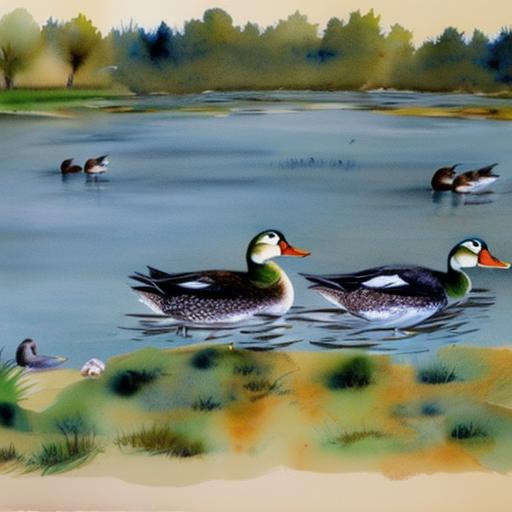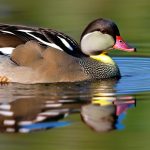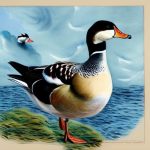Call ducks are a popular breed among duck enthusiasts due to their small size, adorable appearance, and friendly demeanor. Breeding call ducks can be a rewarding experience, but it requires careful planning and maintenance of breeding pens to ensure the health and well-being of the ducks. Call duck breeding pens are specially designed enclosures that provide a safe and comfortable environment for breeding pairs of ducks. These pens are essential for controlling breeding, protecting the ducks from predators, and maintaining hygiene to prevent the spread of diseases. In this article, we will explore the key aspects of setting up and maintaining the perfect call duck breeding pen, selecting the right breeding ducks, managing breeding season, troubleshooting common issues, and the importance of proper care and maintenance in call duck breeding pens.
Key Takeaways
- Call duck breeding pens are essential for maintaining the health and well-being of breeding ducks.
- Setting up the perfect call duck breeding pen involves providing adequate space, shelter, and nesting areas for the ducks.
- Maintaining the health and hygiene of call duck breeding pens requires regular cleaning, disinfecting, and monitoring for any signs of illness.
- Selecting the right breeding ducks for your pen involves considering factors such as breed standards, temperament, and genetic diversity.
- Managing breeding season in call duck breeding pens requires careful monitoring of mating behavior, egg laying, and brooding.
- Troubleshooting common issues in call duck breeding pens may involve addressing issues such as aggression, egg binding, and respiratory infections.
- Proper care and maintenance of call duck breeding pens is crucial for ensuring the health and productivity of breeding ducks.
Setting Up the Perfect Call Duck Breeding Pen
Setting up a call duck breeding pen requires careful consideration of the ducks’ needs for space, shelter, and safety. The pen should be spacious enough to allow the ducks to move around freely and engage in natural behaviors such as foraging, swimming, and mating. It should also provide protection from predators and the elements, with sturdy fencing to prevent escapes and secure shelters for nesting and roosting. The pen should be located in a quiet and secluded area to minimize stress on the ducks and provide a peaceful environment for breeding. Additionally, the pen should have access to clean water for swimming and drinking, as well as ample food sources to support the ducks’ nutritional needs. Proper drainage and ventilation are also important to maintain a clean and healthy environment for the ducks. Overall, the perfect call duck breeding pen should prioritize the ducks’ comfort, safety, and natural behaviors to support successful breeding.
Once the pen is set up, it’s important to regularly inspect and maintain it to ensure that it remains safe and functional for the ducks. This includes checking for any damage to fencing or shelters, cleaning and refilling water sources, removing any debris or waste, and monitoring for signs of pests or disease. Regular maintenance will help prevent potential issues and provide a comfortable and healthy environment for the ducks to thrive.
Maintaining the Health and Hygiene of Call Duck Breeding Pens
Maintaining the health and hygiene of call duck breeding pens is crucial for preventing the spread of diseases and ensuring the well-being of the ducks. Regular cleaning and disinfection of the pen, shelters, and water sources are essential to remove waste, bacteria, and parasites that can harm the ducks. It’s important to use safe and effective cleaning products that are suitable for use around ducks and won’t leave harmful residues. Additionally, providing clean bedding material in shelters and nesting areas will help keep the ducks dry and comfortable while reducing the risk of bacterial or fungal growth.
In addition to regular cleaning, monitoring the ducks for signs of illness or injury is important for early detection and treatment. This includes observing their behavior, appetite, and physical condition, as well as checking for any unusual discharge or wounds. Any ducks showing signs of illness should be isolated from the rest of the flock to prevent the spread of disease and receive appropriate veterinary care. Vaccinations and parasite control should also be implemented as recommended by a veterinarian to protect the ducks from common diseases and parasites.
Furthermore, providing a balanced diet with access to fresh water is essential for maintaining the health of breeding ducks. A nutritious diet will support their reproductive health and provide essential nutrients for egg production and incubation. Regularly monitoring food consumption and adjusting feeding amounts as needed will help ensure that the ducks receive adequate nutrition without overfeeding or wasting food. Overall, maintaining the health and hygiene of call duck breeding pens requires regular cleaning, monitoring for illness or injury, providing a balanced diet, and implementing disease prevention measures to support the well-being of the ducks.
Selecting the Right Breeding Ducks for Your Pen
Selecting the right breeding ducks for your call duck breeding pen is essential for successful breeding and maintaining genetic diversity within the flock. When choosing breeding ducks, it’s important to consider their physical characteristics, temperament, reproductive health, and genetic background. Breeding pairs should be selected based on their conformation to breed standards, such as body size, shape, feather color, and bill shape. This will help ensure that offspring inherit desirable traits and maintain the breed’s standard characteristics.
In addition to physical traits, temperament is an important consideration when selecting breeding ducks. Ducks with friendly and calm temperaments are more likely to successfully mate and raise offspring without aggression or stress. Observing potential breeding pairs for compatibility and behavior towards each other will help ensure harmonious mating and nesting behaviors.
Reproductive health is another crucial factor when selecting breeding ducks. Ducks should be in good physical condition with no signs of illness or injury that could affect their ability to breed or care for offspring. It’s also important to consider their age and breeding history to ensure that they are capable of successful reproduction.
Finally, maintaining genetic diversity within the flock is important for preventing inbreeding and preserving the breed’s overall health and vitality. Breeding pairs should be selected based on their genetic background to avoid closely related individuals mating with each other. This will help maintain a diverse gene pool within the flock and reduce the risk of genetic disorders or weaknesses.
Overall, selecting the right breeding ducks for your call duck breeding pen requires careful consideration of their physical traits, temperament, reproductive health, and genetic background to support successful breeding and maintain genetic diversity within the flock.
Managing Breeding Season in Call Duck Breeding Pens
Managing breeding season in call duck breeding pens requires careful planning and monitoring to support successful mating, egg laying, incubation, and hatching. Breeding season typically occurs in spring when daylight hours increase, triggering hormonal changes in ducks that stimulate mating behaviors. During this time, it’s important to provide suitable nesting areas with clean bedding material for female ducks to lay eggs and incubate them.
Monitoring mating behaviors is essential for identifying successful pairings and ensuring that all females have access to suitable nesting areas. Male ducks may become territorial or aggressive during mating season, so it’s important to observe their behavior towards females and intervene if necessary to prevent stress or injury.
Once eggs are laid, they should be collected daily to prevent them from being damaged or eaten by predators. Eggs can be stored in a cool, humid environment until they are ready for incubation or can be placed under broody hens or in an artificial incubator.
During incubation, it’s important to provide a quiet and secure environment for nesting females to minimize disturbances that could disrupt their brooding behavior. Monitoring nesting females for signs of illness or distress will help ensure that they receive appropriate care if needed.
After hatching, it’s important to provide a warm and safe environment for ducklings to thrive. This includes access to clean water for drinking and swimming, suitable food sources for their nutritional needs, and protection from predators or aggressive adult ducks.
Overall, managing breeding season in call duck breeding pens requires careful observation of mating behaviors, providing suitable nesting areas, collecting eggs daily, monitoring nesting females during incubation, and providing a safe environment for ducklings after hatching.
Troubleshooting Common Issues in Call Duck Breeding Pens

Despite careful planning and maintenance, call duck breeding pens may encounter common issues that require troubleshooting to ensure the health and well-being of the ducks. Some common issues include aggression between mating pairs or adult ducks, egg laying problems, infertility, illness or injury, predator attacks, or environmental factors such as extreme weather conditions.
Aggression between mating pairs or adult ducks can disrupt breeding behaviors and cause stress or injury. Intervening to separate aggressive individuals or providing additional space within the pen can help reduce conflicts and promote harmonious mating behaviors.
Egg laying problems such as soft-shelled eggs or egg binding can occur due to nutritional deficiencies, stress, or reproductive disorders. Providing a balanced diet with adequate calcium supplementation can help prevent egg laying issues, while monitoring nesting females for signs of distress can help identify egg binding early for prompt veterinary care.
Infertility may occur due to age-related factors or reproductive disorders in breeding ducks. Monitoring mating behaviors and fertility rates can help identify infertile pairs early on so that alternative breeding arrangements can be made if necessary.
Illness or injury may occur in breeding ducks due to various factors such as infectious diseases, parasites, or accidents within the pen. Regular monitoring for signs of illness or injury will help ensure early detection and treatment to prevent further spread or complications.
Predator attacks can pose a significant threat to the safety of breeding ducks within the pen. Implementing predator-proof fencing, secure shelters, and regular monitoring for signs of predators can help prevent attacks and protect the ducks from harm.
Environmental factors such as extreme weather conditions can also impact the health and well-being of breeding ducks within the pen. Providing suitable shelter from heat, cold, wind, or rain will help minimize stress on the ducks during adverse weather conditions.
Overall, troubleshooting common issues in call duck breeding pens requires careful observation of mating behaviors, providing suitable nesting areas, collecting eggs daily, monitoring nesting females during incubation, providing a safe environment for ducklings after hatching.
The Importance of Proper Care and Maintenance in Call Duck Breeding Pens
Proper care and maintenance of call duck breeding pens are essential for supporting successful breeding outcomes while ensuring the health and well-being of the ducks. Setting up a suitable pen with adequate space, shelter, water sources, food supplies, and environmental enrichment will provide a comfortable environment for breeding pairs to thrive. Regular cleaning, monitoring for illness or injury, providing a balanced diet with access to fresh water will support the health and hygiene of breeding pens.
Selecting the right breeding ducks based on their physical traits, temperament, reproductive health, and genetic background will help maintain genetic diversity within the flock while supporting successful mating behaviors. Managing breeding season requires careful observation of mating behaviors, providing suitable nesting areas collecting eggs daily during incubation while providing a safe environment for ducklings after hatching.
Troubleshooting common issues such as aggression between mating pairs or adult ducks egg laying problems infertility illness or injury predator attacks environmental factors requires careful observation intervention when necessary prompt veterinary care predator-proof fencing secure shelters regular monitoring for signs of predators providing suitable shelter from extreme weather conditions will help ensure successful breeding outcomes while maintaining the health well-being of call duck breeding pens overall proper care maintenance call duck breeding pens are essential for supporting successful breeding outcomes while ensuring health well-being ducks .
Additionally, providing a balanced diet, access to clean water, and proper sanitation in the breeding pens is crucial for the overall health and well-being of the ducks. Regular cleaning and disinfection of the pens will help prevent the spread of diseases and parasites. It is also important to provide enrichment activities and space for the ducks to exercise and socialize. By addressing these common issues and providing proper care, call duck breeding pens can support successful breeding outcomes and maintain the health and well-being of the ducks.
If you’re looking to create the perfect environment for your ducks, consider investing in high-quality breeding pens. These pens provide a safe and comfortable space for your ducks to breed and raise their young. In fact, according to a recent article on PoultryWizard.com, “The Chicken Coop Country Diner,” having well-designed breeding pens can significantly improve the success rate of duck breeding and ensure the health and well-being of your flock. To learn more about creating the ideal living space for your ducks, check out the full article here.
FAQs
What are call duck breeding pens?
Call duck breeding pens are specially designed enclosures or areas where call ducks are kept for the purpose of breeding. These pens are designed to provide a safe and comfortable environment for the ducks to mate, lay eggs, and raise their young.
What are the key features of call duck breeding pens?
Call duck breeding pens typically include features such as nesting boxes, water sources, feeding areas, and secure fencing to protect the ducks from predators. The pens are often designed to be easily cleaned and maintained, and may include separate areas for mating, nesting, and raising ducklings.
Why are call duck breeding pens important?
Breeding pens are important for call duck breeders to control the breeding process, monitor the health and behavior of the ducks, and ensure the safety of the ducklings. They also help to prevent interbreeding with other duck species and provide a controlled environment for successful breeding.
What should be considered when setting up call duck breeding pens?
When setting up call duck breeding pens, factors such as space requirements, ventilation, protection from predators, and access to food and water should be carefully considered. The pens should also be designed to allow for easy access for cleaning and monitoring the ducks.
Are there different types of call duck breeding pens?
Yes, there are different types of call duck breeding pens, ranging from simple outdoor enclosures to more elaborate indoor setups with heating and lighting. The type of pen used may depend on the breeder’s specific needs, available space, and local climate.
Meet Walter, the feathered-friend fanatic of Florida! Nestled in the sunshine state, Walter struts through life with his feathered companions, clucking his way to happiness. With a coop that’s fancier than a five-star hotel, he’s the Don Juan of the chicken world. When he’s not teaching his hens to do the cha-cha, you’ll find him in a heated debate with his prized rooster, Sir Clucks-a-Lot. Walter’s poultry passion is no yolk; he’s the sunny-side-up guy you never knew you needed in your flock of friends!







